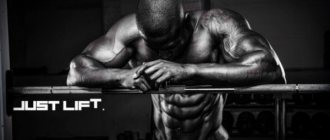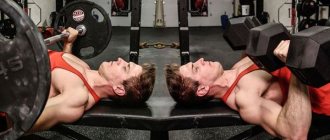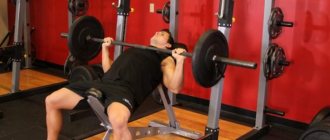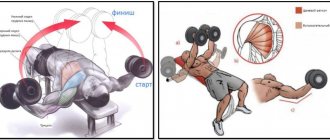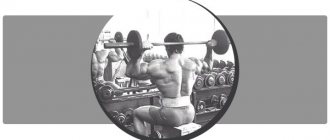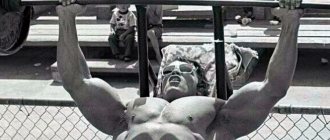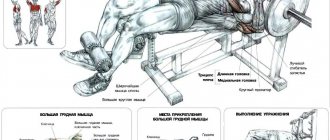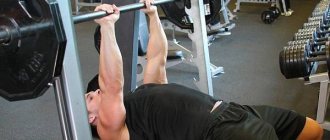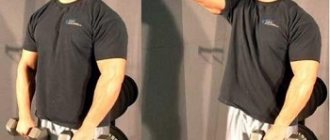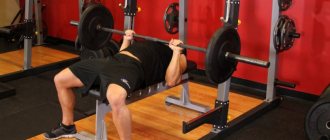The head-down barbell press is aimed at primarily developing the lower part of the pectoral muscle. This exercise helps to “separate” the chest muscles from the abs and get a beautiful relief. The exercise is used as a special preparatory exercise in American football, tennis, golf and gymnastics. It is rarely used in powerlifting and the bench press, since the range of motion of the shoulder joint is increased, and the athlete can be susceptible to injury when the bench press is too long.
The movement is more common in bodybuilding. The goal of the work is to draw the very “line” that separates the chest muscles from the abdomen. In terms of complexity, this is a fairly demanding movement. It requires the help of the belayer and the accuracy of the athlete himself. The exercise works the chest muscles, anterior deltoids and triceps. The back and leg muscles stabilize the athlete’s body in the exercise.
The benefits and disadvantages of the dumbbell bench press
It is a mistake to perceive the dumbbell bench press as an alternative to the barbell. These are different exercises that have their own differences and characteristics. The main benefits of the dumbbell press:
- More focused chest work, as opposed to barbell work.
- No need to work in tandem with a partner for backup.
- Complete safety when performing the movement.
- Regardless of arm length and other individual characteristics (which may prevent you from working correctly with the barbell), the dumbbell bench press is suitable for everyone.
- Developing a sense of balance.
And also read how to do a bench press →
Despite its high benefits, the dumbbell bench press has several disadvantages:
- Standing up with weights after finishing a set requires some preparation (you can simply throw the weights on the floor, but this increases the risk of injury).
- When the weight is lowered, the muscles are stretched more. This can become a problem when rehabilitating from an injury or lifting heavy weights (especially if you lose weight control).
Bench Press Assistance Exercises
Georgy Funtikov
During the off-season, training for a strongman is similar to training for a bodybuilder, the tasks and goals partly coincide - the development of lagging muscle groups, general mass gain, only as he approaches the competition, the arsenal of additional exercises for a strongman decreases (changes), the weights increase, the number of repetitions decreases. The higher the class of a strongman, the more clearly the division of the training cycle into phases is expressed, the wider his arsenal of auxiliary exercises should be. Auxiliary exercises can be divided into three main groups.
- The first group includes those exercises that powerlifters will perform everywhere - they are aimed at “pumping up” the main muscle groups.
- The second group includes exercises used to level out “weak” areas and improve technique.
- The third group is exercises aimed at developing antagonistic muscle groups, that is, those muscles that are not directly involved in squats, bench presses and deadlifts.
The training cycle mainly consists of three phases
- The “pumping” phase - this phase mainly comes down to gaining muscle mass
- Intermediate phase - the phase of transition from “pumping” to working with weights by percentage (increasing strength endurance, improving technique and speed-strength qualities)
- Direct preparation for competitions - classic power percentage schemes
The exercises of the first group are used, as a rule, in all phases. Exercises aimed at developing antagonists can be done in any phase. Exercises of the second group are used only during the 2nd phase (sometimes also in the 1st phase). It’s quite easy to identify weak points; break the movement into three (or more) phases:
- if you have problems with the bar falling off, then there is a problem with the development of the deltoid and the outer part of the chest
- “stops” in the middle - weak chest and poor acceleration (stall) from the chest
- you can’t push at the end - weak triceps (usually the bottom) or weak will (just kidding).
- you can’t “normally” lower (the projectile vibrates - your arms seem to be under current) the barbell to your chest - problems with the development of the brachioradialis muscle, biceps, lats, posterior deltoid and forearms.
Classification of exercises depending on the stage of preparation
| Phase 1 (pitching) |
|
| Phase 2 (transition from pitching to percentage schemes) |
|
| Phase 3 (preparation for competitions) |
|
Selection of basic exercises to “work on” “weak points”
Exercises are listed in descending order of effectiveness
| problems with falling off the chest and poor acceleration of the barbell |
|
| the bar gets stuck in the middle |
|
| problems with pressing the barbell |
|
| poor stabilization of the bar when lowering to the chest |
|
Close grip bench press
The exercise is aimed at developing the anterior bundle of the deltoid muscle and triceps.
Recommended number of repetitions - 2-8 in 3-5 approaches Bench press on an inclined bench
The exercise is aimed at developing the anterior bundle of the deltoid muscle and triceps.
The grip should not be too wide. The recommended number of repetitions is 2-8 in 3-5 approaches. Seated barbell press from the chest with a medium or wide grip.
The exercise is aimed mainly at developing the anterior deltoid muscle.
It is best performed using an inclined bench - a small angle reduces the risk of injury, since the shoulder joint works under more natural biomechanical conditions. The recommended number of repetitions is 3-8 in 3-5 approaches. Dips.
The exercise mainly works the triceps, lower chest and anterior deltoid. The exercise should be performed with a relatively small amplitude - it should not exceed the amplitude of the bench press with an average grip; excessive depth of push-ups inevitably leads to to shoulder injury.
Recommended number of repetitions - 3-8 in 3-5 approaches Dumbbell press fly on a horizontal bench
The exercise works the middle and lower part of the pectoral muscle This exercise is a cross between a dumbbell press fly, the movement in the positive phase should be as fast as possible Recommended number of repetitions - 3-8 in 3-5 sets The last three exercises are the main auxiliary exercises for the bench press, they should be done constantly (at least once a week each)
Incline dumbbell fly press
The exercise works the middle and lower part of the pectoral muscle This exercise is a cross between a dumbbell press fly, the movement in the positive phase should be as fast as possible, the incline angle should be at least 45 degrees.
Recommended number of repetitions - 3-8 in 3-5 approaches French bench press lying on a horizontal bench
The exercise is aimed at working the lower part of the triceps When performing this exercise, you should take into account its risk of injury - excessive weight of the projectile is guaranteed to lead to chronic injury to the elbow joints Recommended number of repetitions - 5 -8 in 3-5 approaches
French bench press of a barbell lying on the floor (barbell and you lie on the floor)
The exercise is aimed at improving the “pressure” of the barbell in the classic bench press When performing this exercise, you should take into account its risk of injury - excessive weight of the apparatus is guaranteed to lead to chronic injury elbow joints, in addition, try to constantly develop maximum power Recommended number of repetitions - 4-8 in 3-5 approaches
Arm extensions on a vertical block
The exercise is aimed at developing the triceps Recommended number of repetitions - 5-8 in 3-5 approaches
Pressing the barbell from a dead point
The exercise is used to work out a “weak” spot in the bench press.
The amplitude depends on what phase of the movement you are having problems with - the “dead center” phase. Recommended number of repetitions - 5-8 in 3-5 approaches. Barbell press with maximum back deflection.
The exercise is used to “search” for the most favored nation trajectory. It should be performed as follows: rest your legs and trapezoid on the bench, arch your back as much as possible, the amplitude should be minimal.
The recommended number of repetitions is 2-5 in 3-6 approaches. Dumbbell swings while standing forward (alternating)
The exercise is aimed at developing the anterior deltoids.
It should be performed using the muscular strength of only the front beam (without cheating), the hand should be slightly relaxed. The recommended number of repetitions is 6-8 in 3-4 approaches. A group of exercises aimed at developing antagonist muscles for the bench press. Bent-over barbell row.
The exercise is aimed at developing the lats, which perform a stabilizing function when performing the bench press.
The grip should be the same as when doing the bench press, relaxed. The recommended number of repetitions is 5-6 in 3-4 approaches. Lifting the barbell for biceps while standing with a reverse grip.
The exercise is aimed at developing the brachioradialis muscle and forearms, partial biceps. It should be performed with a light weight, cleanly (without cheating).
Recommended number of repetitions - 8-10 in 3-4 approaches Barbell curls for biceps
The exercise is aimed at developing the biceps, which stabilizes the movement when performing the bench press. Recommended number of repetitions - 6-8 in 3-4 approaches.
Biceps curls with a dumbbell with one arm in an incline position.
The exercise is aimed at developing the biceps, which stabilizes the movement when performing the bench press. The recommended number of repetitions is 6-8 in 3-4 approaches.
What muscles work
When pressing dumbbells on a straight bench, the work involves:
- Large chest.
- Small chest.
- Anterior deltoids.
- Triceps.
The main load goes to the chest, the muscles of the shoulders and arms work as additional ones.
The position of the hands and grip determines which muscles work in the dumbbell bench press. This allows you to change the focus of the load, which is impossible to achieve with a barbell.
Neutral grip dumbbell press
When using a neutral grip, the elbows are subject to much less negative impact. This may be useful for those who experience joint problems. Also, with this position of the hands, part of the load is shifted to the biceps, so it is important to focus the load on the pectorals. Another dumbbell bench press with a parallel grip while lying down switches the load to the upper part of the pecs even without changing the angle of the bench.
Dumbbell press with direct grip
When using a straight grip (classic version), the load is shifted to the front deltoids and partially to the outer part of the forearm. This is the optimal arm position for even load on the chest (main impact), triceps and deltoids.
Dumbbell bench press technique
This is one of the few exercises in which you should take into account not only the execution of all elements of the movement, but also the removal of the projectile to the starting position.
Technique for performing dumbbell bench press:
- Sit on the edge of the bench. Place weights on your hips. Lean back while lifting your hips to push (to bring the implements into position).
- In the starting position, the back and back of the head should be pressed tightly to the surface. The weight is held on extended arms (with slightly bent elbows) so that the forearms are perpendicular to the floor.
- Start lowering the weights downwards at a moderate pace until they lightly touch your chest.
- With a powerful movement, push the weight back to the starting position without straightening your elbows completely.
It is important that lowering the weight be done a little slower than lifting it. It is also necessary to ensure that the back of the head is pressed tightly against the back throughout the entire exercise. After finishing the set, lower the weight to your chest, push up with your back and assume a sitting position.
Correct technique
Preparation
- Choose a bench of sufficient height so that the thigh is parallel to the floor when the knees are bent;
- Take dumbbells in your hands, sit on a bench, place the weights on your thighs;
- Helping yourself with your feet, bring the dumbbells up to chest level;
- Stabilize the shoulders by bringing the shoulder blades toward the spine
Movement
- By stretching the chest muscles, slowly lower your arms parallel to the forearm with the floor;
- Elbows are slightly bent, not “inserted” into a straight position;
- Achieve maximum chest stretch by slightly pushing the chest upward;
- Bring your hands to the starting position;
- Additional contraction of target muscles at the top point
Chest muscles. Lifting hands with dumbbells while lying down.
Attention
The movement should not turn into a press, due to the full bending of the arms at the elbow joints. You should gently lower your arms and return them to their original position, concentrating only on the chest muscles.
Hitting the dumbbells against each other at the top makes the work easier due to inertia, and therefore should not be allowed.
Lowering the implements too deeply without warming up is the cause of injuries to the shoulder and elbow joints.
Misalignment of the feet, lack of firm support with the legs and displacement of the back on the bench can cause a change in the load vector, so they should be avoided.
You need to make sure that the dumbbells move along an imaginary path passing through the center of the chest and come together in the middle. Bringing them to the eyes changes the vector of force application and prevents stress.
Recommendations
Beginners begin to master the movement in the usual technique, palms parallel to each other, dumbbells facing each other. Movements with the hands are not allowed, as they can distract the novice athlete from mastering the technique and adequate distribution of force.
If the dumbbells are heavy, it is recommended that the spotter lift them up, or you can use the technique of bringing the weight up with your legs, which was indicated above.
How to pump up your chest. Lying dumbbell fly
Features of the dumbbell bench press lying on the floor
The dumbbell floor press is one of the variations that has a specific purpose. This technique is characterized by partial amplitude and serves to overcome stagnation and a “dead spot” in development. Also, this dumbbell chest press can be suitable for beginners with a low level of physical fitness.
Technique:
- Take the shells and lie down on the floor. Throw them above you so that your arms are perpendicular to the floor.
- Slowly lower the weight so that your elbows point out to the sides.
- Once your triceps hit the floor, without pausing, press the weight away from you at a faster pace.
In this exercise, it is important that the athlete does not “rest” at the bottom point when the hands are on the floor. This will significantly reduce the efficiency of movement. The return should be without inertia or delay, followed by a rise at a fast or even explosive pace.
Step-by-step execution technique
Step 1:
- Shells of optimal weight are picked up with a neutral grip and thrown while lying on a bench, on your chest, using your knees or using the help of a partner.
- In the starting position: the apparatus is placed at the top on bent arms, there is a natural arch in the lower back, and the legs are resting on the floor.
Step 2:
- While inhaling, the projectiles are moved slowly to the sides, describing a wide arc.
- In the lower extreme position, stretching should be felt.
- When they reach chest level, squeeze the chest muscles, then, along the same trajectory, return to the starting point, exhale.
Step 3:
- Without allowing the dumbbells to touch, they linger for a second at the top point and repeat the movements.
- You need to do it a specified number of times.
To better understand the technique, below is a picture version:
Dumbbell bench press with a narrow, neutral grip
The dumbbell press with a neutral grip is an option with a change in grip. It is aimed at switching the focus of the load to the upper chest. Also, part of the load switches from triceps to biceps. This should be taken into account so that the biceps brachii muscle does not take part of the load.
The technique of performing a dumbbell bench press with a narrow grip does not change in comparison with other options. It is important to consider that in this exercise the position of the hands does not change throughout the entire movement. A technique in which the position of the hands changes from neutral to straight does not apply to the close-grip dumbbell press.
Useful tips
If you follow the recommendations presented below, you can confidently speak about the correct technique and that it is possible to achieve your goal in the shortest possible time:
- The movements should be performed slowly, focusing on contracting and stretching the pectoral muscles;
- at the top point, do not linger for a long time and do not touch the dumbbells;
- lower the dumbbells down to a comfortable position, trying to use the “full” range of motion;
- keep the projectile as far away from the body as possible to use a wide semicircle of movement.
Single dumbbell bench press
In fitness, the one-arm bench press is almost never used. This option requires additional activation of stabilizer muscles in order to maintain the position of the arm with the weight. The technique is commonly used by bench lifters. This option potentially increases strength performance.
Technique:
- Take the projectile in your hands and lie down on the bench. With your other hand, firmly hold the bottom of the bench to stabilize your body.
- Begin to slowly lower your hand until the pancake lightly touches your chest.
- Without pausing, press the weight back to the starting position without straightening your elbow.
The downside is increased trauma , so this exercise should be done with extreme caution.
Unlike other versions, when working with one hand, the lowering and raising of the projectile occurs slowly and under control, without jerking or inertia. Therefore, it is important to carefully select the weight of the burden .
#2 Flyes with one dumbbell on the floor
By analogy with the previous exercise with one dumbbell, you can also perform flyes. The core muscles here will also receive increased load, and as a bonus you will get the opportunity to focus the load on the lagging side of the pectoral muscles , if this problem is relevant to you.
The exercise can be performed both on a bench and on the floor. We will look at the second option.
Starting position
Lie down on the floor. Bend your knees, place your feet on the floor. Hold the dumbbell with a neutral grip. The arm is barely bent at the elbow and perpendicular to the floor. The second one is set aside.
We carry out
As you inhale, slowly lower the dumbbell down, leaving the angle at your elbow unchanged.
As soon as the dumbbell reaches a horizontal position, try not to release the tension in your pecs by resting your elbow on the floor.
As you exhale, return the dumbbell to the starting position.
Adviсe
- The negative phase, when you lower the weight, should be longer than the positive phase, when you return to the starting position.
- Taking a deep breath will help to better stretch the chest at the bottom. Especially if you are doing the exercise on a bench.
- Keep your elbows in during the exercise. A very slight bend should always be maintained.
- Don't squeeze the dumbbell too hard, as this can reduce activation of the pectoral muscles.
Recommendations
This is one of the most beneficial chest exercises. The dumbbell press on a horizontal bench, together with the regular barbell press, will provide a powerful workout for the entire group (work with dumbbells should always be after the barbell).
For decades in bodybuilding, the alternating incline bench scheme has proven itself to be excellent. For example, if you initially worked with a barbell on a horizontal surface, then it is better to use dumbbells at an angle and vice versa. Read more about the incline dumbbell press →
The number of repetitions and sets depends on the training regimen.
- In multi-rep cycles, 3-4 sets of 12-15 repetitions are usually done.
- In classic work for mass – 3-4 sets of 10 repetitions.
- To develop strength, a series of 5 sets of 6 repetitions is used (relevant only for men).
The dumbbell press for girls is no different in terms of technique. However, it is recommended to increase the number of repetitions to 12-20, especially when working with moderate weights. This is due to the higher endurance of the chest muscles in women. For muscle hypertrophy, it is recommended to work with a weight of 60-65% of 1RM in the “4*10” mode.
In general, many athletes “feel” their pecs much better when working with dumbbells. Also, this embodiment is ideal for drop sets and safe refusal approaches without the help of a partner.
